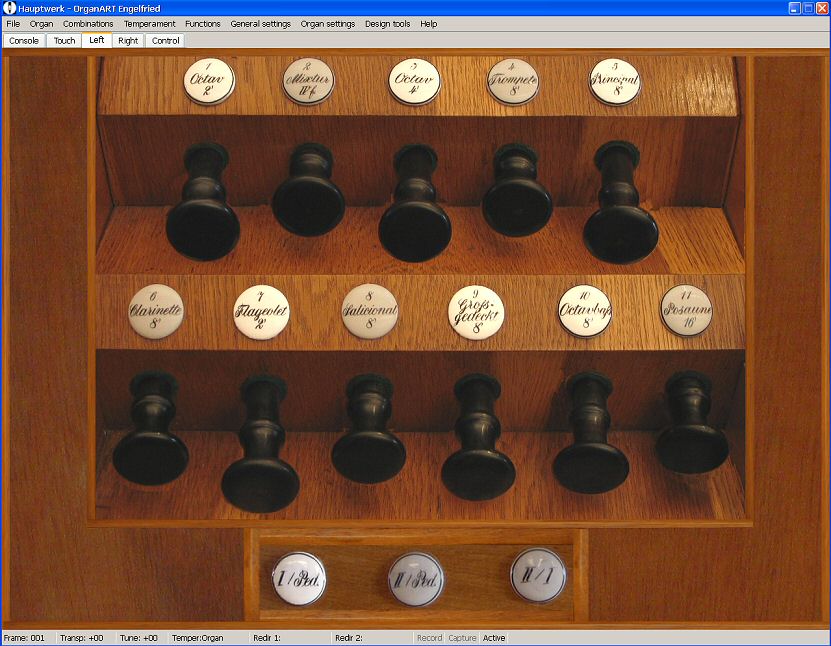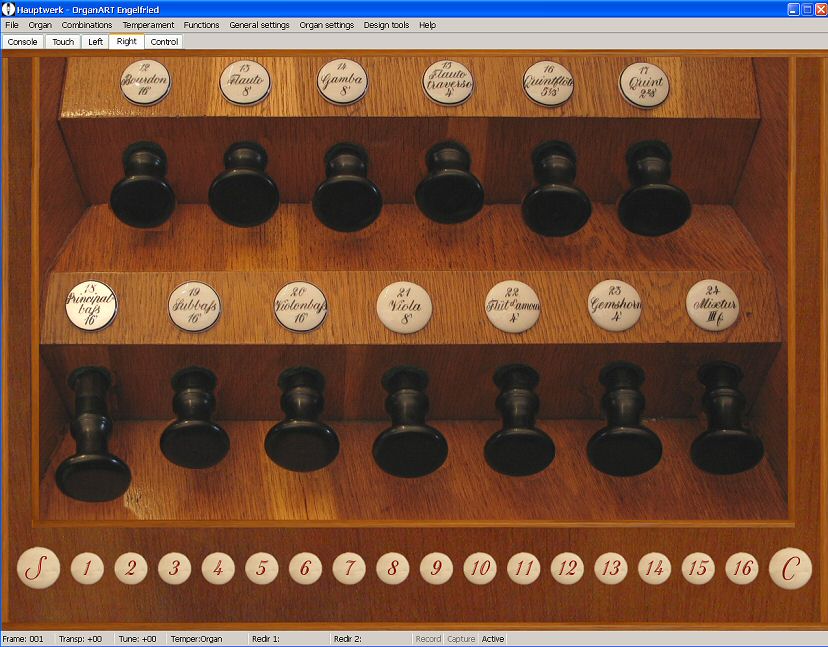1844 Franz Xaver Engelfried Organ
Ev. Peter and Paul Church, Gönningen/Baden-Württemberg, Germany
Short Introduction and History
The instrument is located in a medium-sized historical church in south-west Germany near Stuttgart, which was extended by neo-gothic style in 1842. The architecture is based on tuff stone material and is famous for its excellent acoustical properties. Many international CD productions have been recorded there; see the related special link. The organ includes classical stops with expressive chiff, as well as typical romantic stops such as the Salizional, Viola and Clarinette.
The organ was built in 1844 by Franz Xaver Engelfried of Horb, Germany, and had to bear several modifications in the 19th century due to changing preferences during that period. For example, the reed stops were completely removed and other significant changes in pipe voicing were made.
In 1970, organ builder Richard Rensch of Lauffen, Germany, was entrusted with the reconstruction of the original early romantic specification of the organ, and with some extensions. Fortunately, documentations of the original organ were found, together with parts of its reed stops, making an accurate reconstruction possible. It is very important to state , that there was no general movement for the restoration of such romantic organs in Germany in 1970. There were plans, to remove this organ!
Cleaning and a general overhauling took place in 2005 by organ workshop Rensch
The instrument is one of very few early romantic organs that still exist in Germany.
The stops are charming and very colourful, especially appropriate for playing organ music of the 18th and 19th centuries, but even Bach sounds very convincing. The instrument has a mechanical tracker action, mechanical couplers and is fully playable and in very good shape. The pedalboard was virtually extended upwards to f1 to enable the playing of literature with special requirements, such as the J. S. Bach Trio Sonatas
The church room has a medium-wet acoustics with about 3,5 seconds of reverberation.
See Location in Googlemaps
Recording technique
The organ was again recorded in January 2008 with 48 kHz, 24 bit, multi-channel, for Hauptwerk 3, using the multi-layer release and multi-attack technique introduced by OrganArt. All stops were recorded with multiple release levels for short, medium and long key attacks.
All stops, which have a significant attack-sensitive behaviour, will be additionally available later on with original multiple attack samples (actually not available)
Thanks
I would like to thank the parish of Gönningen for supporting this project. Special thanks are due to Pastor Alexander Behrend and Beate Heisel for local assistance!
Last but not least special thanks to my wife, who assists all projects and is responsible for the photo documentation.
Virtual Console
Specification
Organ temperament: Slightly modified equal temperament at a1=440 Hz.
NOTE: Click on the stop names for a small sound demo!
Hauptwerk (C–f3)*01. Bourdon 16 Hinterwerk (C–f3)*01. Großgedeckt 8 |
Pedal (C–c1)*01. Principalbaß 16 |
CouplersHIW-HW (Hook Coupler) * Extended Version:Manuals C–g3 |
Requirements
Loaded Version |
Memory Requirements 3) |
Processor Speed 2) |
|
16-bit, compressed1), single loop |
1900 MB |
≥ 2 GHz SingleCore |
|
16-bit, compressed, all loops |
2200 MB |
≥ 2 GHz SingleCore |
|
24-bit, compressed, all loops |
4100 MB |
≥ 2 GHz SingleCore |
1) Lossless compression (no loss of sound quality!)
2) Recommended: Dual-Core, 4 GByte RAM
3) To load this organ into Hauptwerk you will need enough free memory in your computer, due to the amount of playable stops, not including the operating system or any other programs that may be running!
We recommend a professional audio card (e.g. RME-Series) and a studio headphone (e.g. AKG Reference Headphone K701, K712) for optimal sound and room impression.
Demos
The following demo pieces were recorded with the Hauptwerk Advanced Edition software and the virtual organ sample set, with no additional effects processing.
Live recorded demos by Anton Doornhein, Niederlande:
F. Mendelssohn-Bartholdy (1809-1847)
Sonate No.6 d-moll op.65, 6 Registration
1st Mvmt: Choral, Andante sostenuto, Allegro molto 8:52 min
2nd Mvmt: Fuge 2:42 min
3rd Mvmt: Finale 2:37 min
W. A. Mozart (1756-1791)
Ouvertüre in C KV399
Adagio in C KV356
Leipziger Gigue KV574
Joseph Haydn (1732-1809) Flötenuhrstücke
No. 1: Allegro moderato
No. 11: Menuett
No. 12: Presto
Moritz Brosig (1815-1887)
Präludium in F
Choral "Nun komm' der Heiden Heiland"
Choral "Ach bleib' mit Deiner Gnade"
Präludium in D
Louis Lefébure-Wely (1817-1869)
Pieces from L’Organiste Moderne. Collection de Morceaux d’Orgue dans tous les Genres, op.122
Andante No. 1
Verset
Andante No. 5
Elevation ou Communion
Pastorale
Robert Schumann (1810-1856)
Fuge Nr. 1 über BACH op. 60, 1
Numerous other live recordings can be found on the ConcertHall Website
(Advanced Search, Organ: OAM - F.X. Engelfried Gönningen)
© OrganArt Media, all rights reserved
No demo sounds may be used or transmitted in any form for public purposes without the prior written permission of the publisher!
Informations, Discography and Weblinks
Organ Builder, Restoration:
Church Community and History:
Discography (Selection)
- Under construction -
The author takes no responsibility for the contents of linked pages!













